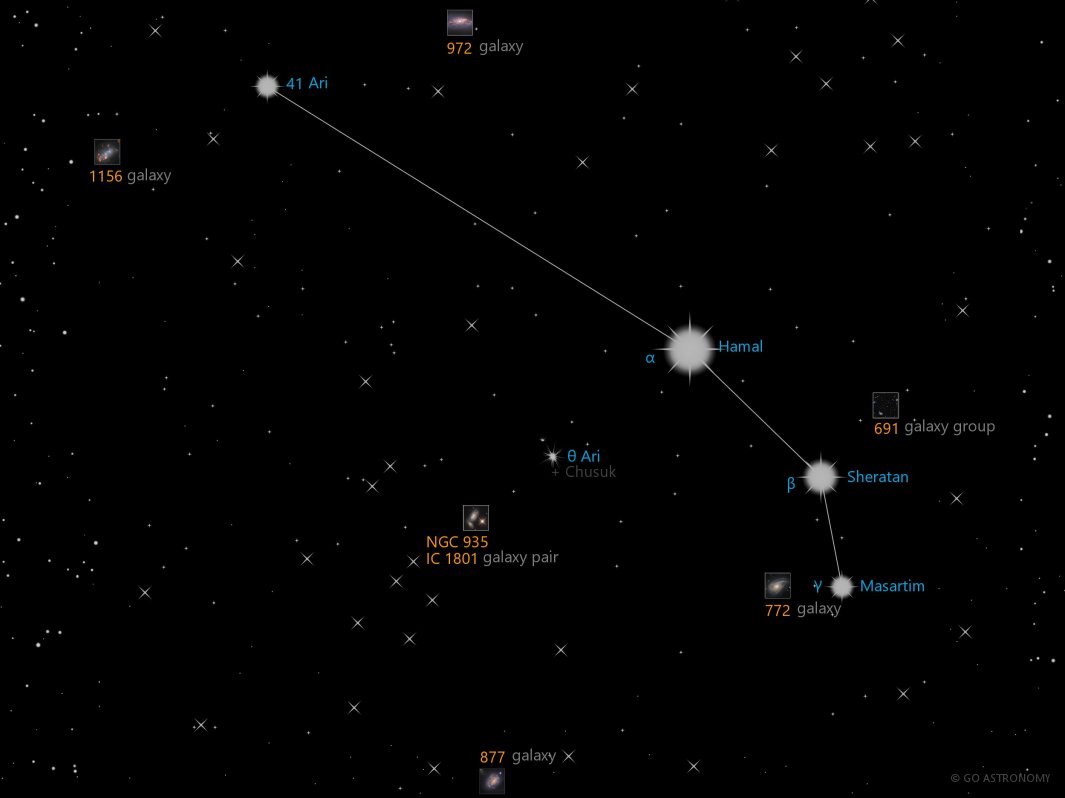Aries, the Ram (Ari)
(AIR-eez)
The Northern constellation of Aries, the Ram, is best viewed in Winter during the month of December.
Aries is the 39th largest constellation. It's brightest star is Hamal at magnitude 2.00. The boundary of the Aries constellation contains 11 stars that host known exoplanets.
- Pronunciation:
- AIR-eez
- Meaning:
- Ram
- Genitive:
- Arietis
- Abbreviation:
- Ari
- Constellation Family:
- Zodiacal
- Hemisphere:
- Northern
- Quadrant:
- NQ1
- Visibility:
- 90° N - 60° S
- Best viewing month*:
- December
- Area:
- 441 sq. degrees
- Size:
- 39th largest
- Right Ascension (avg):
- 2h 41m
- Declination (avg):
- 21°
- Brightest star:
- Hamal (2.00)
- Stars with planets:
- 11
- Messier objects:
- |
- Caldwell objects:
- |
Brightest Stars in Aries
The 10 brightest stars in the constellation Aries by magnitude.
- Star
- Magnitude
- Spectral class
- Alpha Arietis (α Ari)
- 2.01
- K2III
- Beta Arietis (β Ari)
- 2.64
- A5V
- 41 Arietis (41 Ari)
- 3.61
- B8Vn
- Delta Arietis (δ Ari)
- 4.35
- K2IIIvar
- HD 20644
- 4.47
- K2II-III
- 39 Arietis (39 Ari)
- 4.52
- K1III
- Gamma Arietis (γ2 Ari)
- 4.62
- kA0hA3(IV)SiSr
- 35 Arietis (35 Ari)
- 4.65
- B3V
- Gamma Arietis (γ1 Ari)
- 4.7
- B9.5IV
- Lambda Arietis (λ Ari)
- 4.79
- F0V
Double Stars in Aries
These are the brightest and easiest-to-find double, triple, and quadruple star systems in the constellation Aries. Also see all star clusters.
- Star system
- Magnitudes
- Type
- Gamma Arietis
- 4.5, 4.6
- double
- Lambda Arietis
- 4.8, 6.6
- double
Galaxies in Aries
The most notable galaxies in the constellation Aries. Also see all galaxies.
Milky Way Satellites in Aries
Dwarf satellite galaxies that orbit the Milky Way Galaxy located in the constellation Aries. Also see all Milky Way satellite galaxies.
- Galaxy name
- Alt name
- Magnitude
- Segue 2
The Celestial Ram
Aries, the Latin term for 'The Ram', is a mid-sized constellation in the Northern Hemisphere known for its historical significance, captivating mythology, and intriguing astronomical features. Although its stars are relatively faint, the constellation is easily located due to its position along the ecliptic and its proximity to more notable celestial bodies.
History and Mythology
Aries is one of the 48 ancient constellations described by the 2nd-century astronomer Claudius Ptolemy and is among the 88 modern constellations recognized by the International Astronomical Union today. Its depiction as a ram originates from ancient Babylonian astronomy, though its significance varies across cultures. In Greek mythology, Aries is often associated with the golden ram that rescued Phrixus and took him to Colchis, where the Golden Fleece remained.
Location and Main Features
Located in the first quadrant of the Northern hemisphere (NQ1), Aries can be seen at latitudes between +90? and -60?. It's bordered by Perseus, Taurus, Cetus, Pisces, and Triangulum. The constellation lies along the ecliptic path?the apparent path the Sun takes across the sky over the year, which makes it part of the twelve constellations of the zodiac.
Aries' most notable stars form a distinctive line. They are Hamal (Alpha Arietis), Sheratan (Beta Arietis), and Mesarthim (Gamma Arietis). Hamal, the brightest, is an orange giant approximately 66 light-years away and has a magnitude of 2.0, making it the most visible star in Aries.
Deep Sky Objects
Aries hosts several faint galaxies, including the spiral galaxy NGC 772 and its companion NGC 770. The former is notable for its extended, asymmetrical spiral arms instigated by the gravitational interaction with its neighboring galaxy. These objects, however, require a decent-sized telescope due to their faintness and distance from Earth.
Observing Aries
Aries, located between the more easily recognizable constellations of Pisces to the east and Taurus to the west, is best seen during December around 9 PM. While its primary stars are not particularly bright, they can be seen from a clear, dark location without the aid of a telescope. Aries' three main stars form a curved line that resembles a bent walking stick.
Amateur astronomers using a telescope will appreciate the binary star system Gamma Arietis?Mesarthim. At a separation of 7.8 arcseconds, the system's stars can be split with a small telescope, offering a striking contrast in color as one star shines white and the other blue.
* Constellation shown for northen hemisphere skies. For the southern hemisphere, constellations appear rotated 180 degrees (upside-down and left-right reversed) from what is shown. Remember that seasons are reversed too - summer in northern latitudes is winter in southern latitudes.
** Circumpolar constellations are visible year-round in the hemisphere listed (and not at all in the opposite hemisphere).





